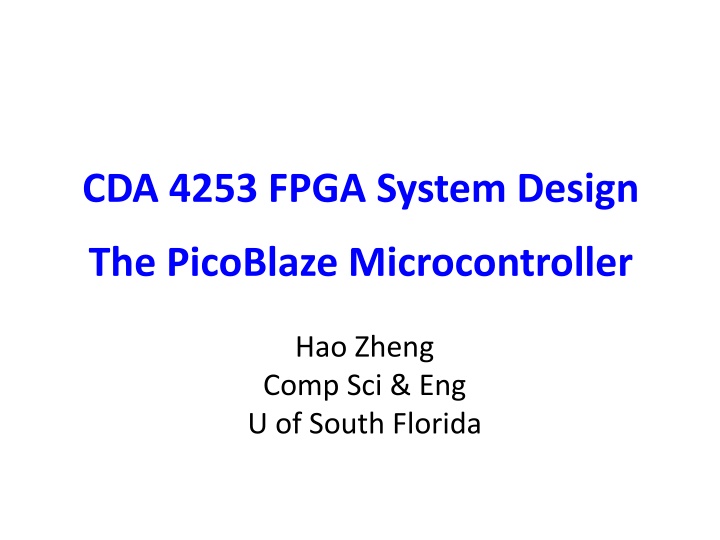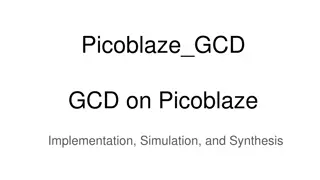
PicoBlaze FPGA System Design Overview
"Explore the PicoBlaze soft-core microcontroller designed in VHDL, its features, applications, and resource utilization in Spartan-6 FPGAs. Learn about its compact size, predictable performance, and recommended reading materials for further understanding."
Download Presentation

Please find below an Image/Link to download the presentation.
The content on the website is provided AS IS for your information and personal use only. It may not be sold, licensed, or shared on other websites without obtaining consent from the author. If you encounter any issues during the download, it is possible that the publisher has removed the file from their server.
You are allowed to download the files provided on this website for personal or commercial use, subject to the condition that they are used lawfully. All files are the property of their respective owners.
The content on the website is provided AS IS for your information and personal use only. It may not be sold, licensed, or shared on other websites without obtaining consent from the author.
E N D
Presentation Transcript
CDA 4253 FPGA System Design The PicoBlaze Microcontroller Hao Zheng Comp Sci & Eng U of South Florida
Overview of PicoBlaze Soft-core microcontroller in VHDL: portable to other platforms. Small: occupies ~20 CLBs. Respectable performance: 50 MIPS Predictable performance: every instruction takes 2 cycles. Suitable for simple data processing and control. 2
Required Reading P. Chu, FPGA Prototyping by VHDL Examples Chapter 14, PicoBlaze Overview Recommended Reading PicoBlaxe 8-bit Embedded Microcontroller User Guide (UG129) K. Chapman, PicoBlaze for Spartan-6, Virtex-6, and 7-Series (KCPSM6) 3
Block diagram of a General-Purpose Processor ctrl 4
Block diagram of a General-Purpose Processor (Microcontroller) 5
PicoBlaze Overview 8-bit data width, 18-bit instruction width, 10-bit program address 6
Size of PicoBlaze-6 in Spartan 6 1. Resource Utilization in CLB Slices 26 CLB Slices 1.1% of Spartan-6 used in Nexys3 2. Number of PicoBlaze-6 cores fitting inside of the Spartan-6 FPGA (XC6SLX16) used in the Nexys3 FPGA board 87 PicoBlaze cores
Speed of PicoBlaze on Basys-3 1. Maximum Clock Frequency 100 MHz 2. Maximum number of instructions per second 50 millions of instructions per second (MIPS)
Register File of PicoBlaze-3 8-bit Address s0 s1 s2 s3 s4 s5 s6 s7 0 1 2 3 4 5 6 7 7 7 7 7 7 7 7 7 0 0 0 0 0 0 0 0 16 Registers sF F 7 0 9
Definition of Flags Flags are set or reset after ALU operations Zero flag - Z zero condition Z = 1 if 0 otherwise result = 0 Carry flag - C overflow, underflow, or various conditions Example* C = 1 if result > 28-1 (for addition) or result < 0 (for subtraction) 0 otherwise *Applies only to addition or subtraction related instructions, refer to the following slides otherwise 10
Interface of PicoBlaze KCPSM = constant (K) coded programmable state machine 11
Interface of PicoBlaze in_port[7:0] input data port that carries the data for the INPUT instruction. 12
Interface of PicoBlaze out_port[7:0] carries the output data for an OUTPUT instruction. 13
Interface of PicoBlaze port_id[7:0] addresses of components connected to PicoBlaze. Holds for two cycles during an INPUT/OUTPUT instruction. 14
Interface of PicoBlaze write_strobe being asserted 1 validates the data on the output_port[7:0]. 15
Interface of PicoBlaze read_strobe being asserted 1 indicates the capture of the data on the input_port[7:0]during an INPUT instruction. 16
Interface of PicoBlaze reset needs to be asserted for at least one cycle. 17
Interface of PicoBlaze interrupt assert it for at least two cycles to trigger an interrupt event in PicoBlaze. 18
Interface of PicoBlaze interrupt_ack acknowledges the current interrupt has been recognized by PicoBlaze. Used to clear the current interrupt. 19
Interface of PicoBlaze Summary Name clk reset address Direction input input output Size Function System clock signal. Reset signal. Address of the instruction memory. Specifies address of the instruction to be retrieved. Fetched instruction. Address of the input or output port. Input data from I/O peripherals. Strobe associated with the input operation. Output data to I/O peripherals. Strobe associated with the output operation. Interrupt request from I/O peripherals. 1 1 10 instruction port_id in_port read_strobe input output input output 18 8 8 1 out_port write_strobe output output 8 1 interrupt input 1 interrupt_ack output 1 Interrupt acknowledgment to I/O peripherals 20
Use of PicoBlaze in VHDL Design PicoBlaze Component Declaration 21
Use of PicoBlaze in VHDL Design PicoBlaze Component Instantiation 22
Use of PicoBlaze in VHDL Design PicoBlaze Program ROM Component Declaration/Instantiation KCPSM3 and prog_rom are generated automatically by the assembler. 23
Development Flow of a System with PicoBlaze 24
Addressing Modes Immediate mode SUB s7, 07 s7 s7 07 ADDCY s2, 08 s2 s2 + 08 + C Direct mode sa sa + sf ADD sa, sf PORT_ID 2a s5 IN_PORT INPUT s5, 2a Indirect mode STORE s3, (sa) RAM[sa] s3 PORT_ID s2 s9 IN_PORT INPUT s9, (s2) 26

